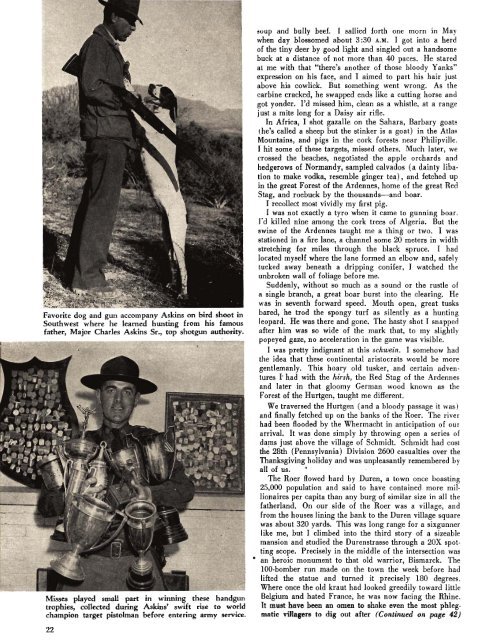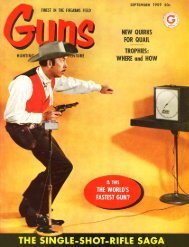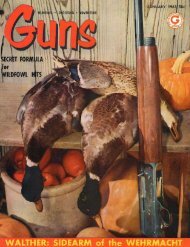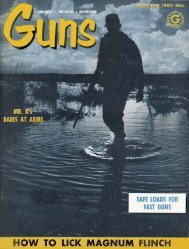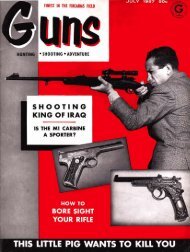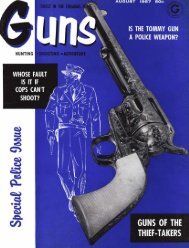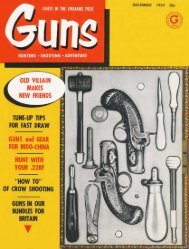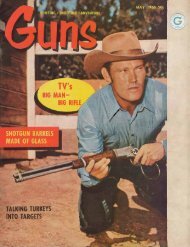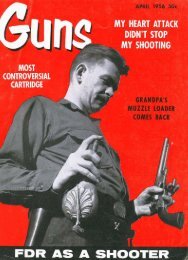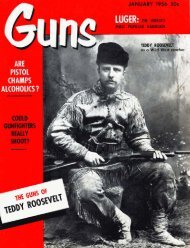Create successful ePaper yourself
Turn your PDF publications into a flip-book with our unique Google optimized e-Paper software.
J<br />
Favorite dog and gun accompany Askins on b- auuot in<br />
Southwest where he learned hunting from his famous<br />
father, Major Charles Askins Sr., top shotgun authority.<br />
Misses played small part in winning these handgun<br />
!: trophies, collected during Asians' swift rise to world<br />
champion target pistolman before entering army service.<br />
22<br />
soup and bully beef. I sallied forth one morn in May<br />
when day blossomed about 3:30 A.M. I got into a herd<br />
of the tiny deer by good light and singled out a handsome<br />
buck at a distance of not more than 40 paces. He stared<br />
at me with that "there's another of those bloody Yanks"<br />
expression on his face, and I aimed to part his hair just<br />
above his cowlick. But something went wrong. As the<br />
carbine cracked, he swapped ends like a cutting horse and<br />
got yonder. I'd missed him, clean as a whistle, at a range<br />
just a mite long for a Daisy air rifle.<br />
In Africa, I shot gazalle on the Sahara, Barbary goats<br />
(he's cded a sheep but the stinker is a goat) in the Atlas<br />
Mountains, and pigs in the cork forests near Philipville.<br />
I hit some of these targets, missed others. Much later, we<br />
crossed the beaches, negotiated the apple orchards and<br />
hedgerows of Normandy, sampled calvados (a dainty liba-<br />
tion to make vodka, resemble ginger tea), and fetched up<br />
in the great Forest of the Ardennes, home of the great Red<br />
Stag, and roebuck by the thousands-and boar.<br />
I recollect most vividly my first pig.<br />
I was not exactly a tyro when it came to gunning boar.<br />
I'd killed nine among the cork trees of Algeria. But the<br />
swine of the Ardennes taught me a thing or two. I was<br />
stationed in a fire lane, a channel some 20 meters in width<br />
stretching for miles through the black spruce. I had<br />
located myself where the lane formed an elbow and, safely<br />
tucked away beneath a dripping conifer, I watched the<br />
unbroken wall of foliage before me.<br />
Suddenly, without so much as a sound or the rustle of<br />
a single branch, a great boar burst into the clearing. He<br />
was in seventh forward speed. Mouth open, great tusks<br />
bared, he trod the spongy turf as silently as a hunting<br />
leopard. He was there and gone. The hasty shot I snapped<br />
after him was so wide of the mark that, to my slightly<br />
popeyed gaze, no acceleration in the game was visible.<br />
I was pretty indignant at this schwein. I somehow had<br />
the idea that these continental aristocrats would be more<br />
gentlemanly. This hoary old tusker, and certain adven-<br />
tures I" had with the hirsh, the Red Stag of the Ardennes<br />
and later in that gloomy German wood known as the<br />
Forest of the Hurtgen, taught me different.<br />
We traversed the Hurtgen (and a bloody passage it was)<br />
and finally fetched up on the banks of the Roer. The river<br />
had been flooded by the Whermacht in anticipation of our<br />
arrival. It was done simply by throwing open a series of<br />
dams just above the village of Schmidt. Schmidt had cost<br />
the 28th (Pennsylvania) Division 2600 casualties over the<br />
Thanksgiving holiday and was unpleasantly remembered by<br />
all of us.<br />
The Roer flowed hard by Duren, a town once boasting<br />
,25,000 population and said to have contained more mil-<br />
lionaires per capita than any burg of similar size in all the<br />
fatherland. On our side of the Roer was a village, and<br />
from the houses lining the bank to the Duren village square<br />
was about 320 yards. This was long range for a sixgunner<br />
like me, but I climbed into the third story of a sizeable<br />
mansion and studied the Durenstrasse through a 20X spot-<br />
ting scope. Precisely in the middle of the intersection was<br />
an heroic monument to that old warrior, Bismarck. The<br />
100-bomber run made on the town the week before had<br />
lifted the statue and turned it precisely 180 degrees.<br />
Where once the old kraut had looked greedily toward little<br />
Belgium and hated France, he was now facing the Rhine.<br />
It must hare been an omen to shake even the most phleg-<br />
matic villagem to dig out after (Continued on page 42)


